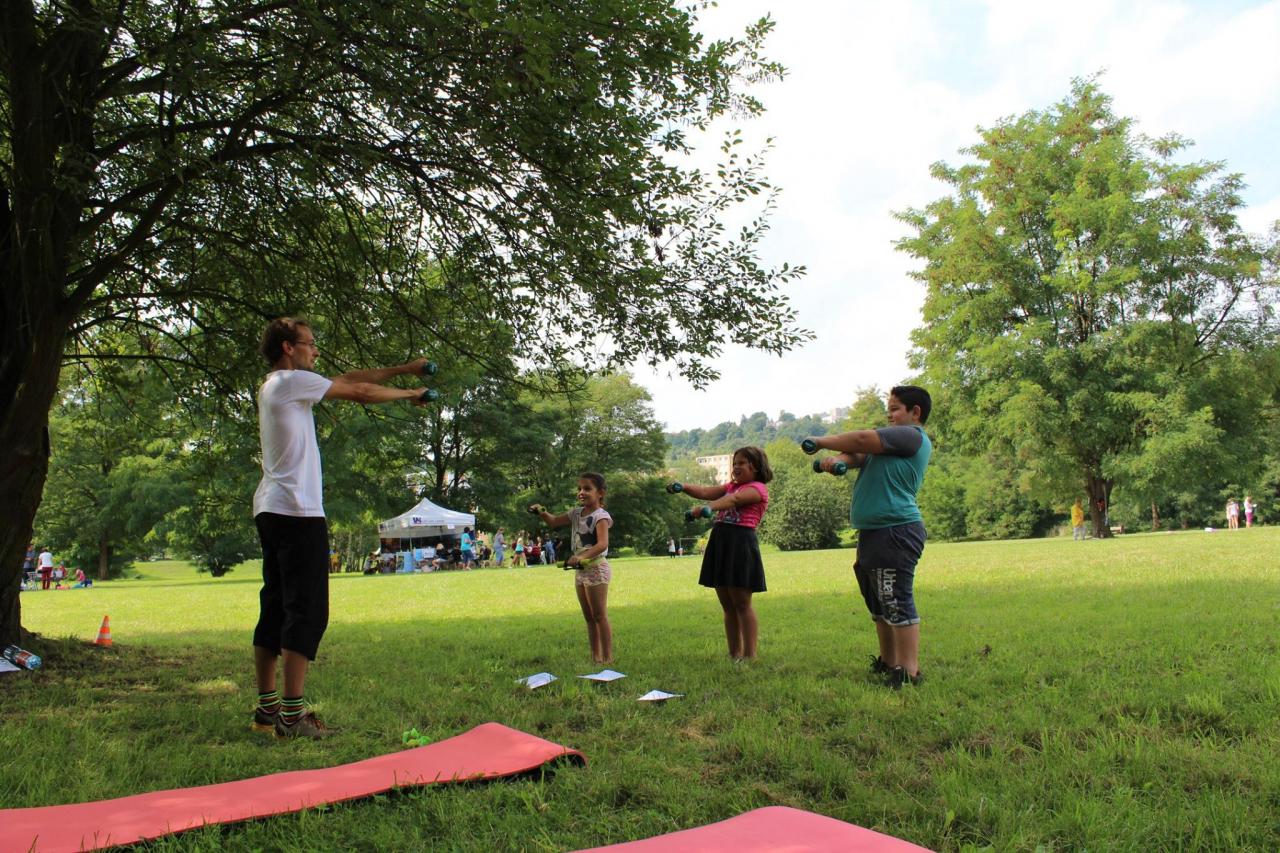
With recent changes in our life styles, opportunities to be physically active are decreasing. This phenomenon is especially apparent in urban areas where sedentary lifestyle is the new norm amongst the working age population. While there is a body of empirical evidence showing associated health risks, it has also been proven that anyone who increases their level of physical activity, even after a long gap, can obtain health benefits irrespective of their age. It is never too late to start. However a group of cities is dedicated this phenomena and therefore decided within the framework of the Vital Cities network, to create a Vital Cities label.
The label is a brand for cities to identify with wishing to combat inactivity and get people back on track to a healthy and physically active lifestyle. The development of the label started in July 2016 and the results of partnership working are now used to develop a feasibility study. The project offers a set of city specific solutions turning open public spaces into low threshold facilities and encourages residents to get involved in regular, preferable daily sport or physical activities.
A key concept behind the initiative is to create a network, a social movement for change. Instead of creating barriers to participation, cities are encouraged to join and share this common aim, making the network successful.
Joining the Network
The VITAL CITIES Label could yield several benefits for participating cities. Firstly, it provides an objective for city management and makes health and well-being a long term strategic priority. It enables cities to make direct steps toward this goal and creates positive marketing around their efforts. Furthermore, a city with this label can become a resource for others by making its knowledge available.
What might cities need to do in order to become a member of the network?
- Demonstrate an understanding of the barriers people in their city face to being more active physically and socially
- Having an action plan including specific projects, initiatives or policies which have to be implemented within a given timeframe
- Be open to sharing evidence and innovation, initiatives and enterprise with other partners and the wider public.
- Commit to participating in the network, including taking part and developing policies and proposals
- Participating in a process of peer reviewing, based on the successful deep dives organized during the Vital Cities lifespan.
Case Studies as lighting examples
In the process of developing the feasibility study, a number of thematically relevant networks have been examined to see whether their operational model could be adopted for VITAL CITIES.
One of these networks was Purple Flag which is a quality mark for the night-time economy in city centres started by the Association for Town Centre Management (ATCM) in the United Kingdom. Launched in 2012 with around 70 members, the initiative allows the public to get quickly informed about city centres that offer and entertaining, diverse, safe and enjoyable night out. The initiative provides benefits for place managers managing the evening and night time economy. For example, managers can receive positive feedback from local businesses, as the platform greatly improves internal and external communication. It also contributes to the improved public image for the location, lower crime and anti-social behaviour, a wider patronage, increased expenditure.The imitative has created a comprehensive set of standards to increase the quality of the night time economy, along with recommendations on management processes and other good practice examples.
Other relevant networks included for instance UNESCO Creative Cities Network, UNICEF Child Friendly Cities Initiative and WHO Safe Communities. Looking at these examples, there are a number of characteristics which they share and may play a strategic role in forming a successful network:
- Clearly defined aim and objectives that members can work towards
- Requirement from members to show long-standing commitment to the common objective and have a realistic action plan
- Sharing resources and knowledge
- Partnership working locally and internationally
- Having a body that provides technical and administrative assistance and can also provide strategic guidance and financial support
- A title bringing international recognition and high visibility
- Carefully developed governance models
Where we are now
The Urbact VITAL CITIES partnership consists of the local authorities of Loulé (P), Birmingham (UK), 13th District of Budapest (HU), Burgas (BG), Krakow (PL), Liepaja (LV), Rieti (IT), Sibenik (HR), Usti nad Labem (CZ) and Vestfold County (N). These Municipalities have agreed to adopt a shared vision and through partnership working, they endeavor that citizens make use of the city’s open public spaces in the vicinity of their homes, lead a more active and healthy lifestyle and experience a higher level of physical and mental wellbeing. Physical activities also improve social integration which can be especially beneficial for more deprived areas.
The purpose of the network is to create a platform for learning and best practice advice and make VITAL CITIES and internationally recognized brand. It also represents basic standards for cities’ relation to the enhanced utilization of public spaces for regular leisure-time physical activity and enhanced involvement of people living in neighborhoods with low socio-economic status, which impacts on social cohesion and healthy living. It also stimulates other Municipalities to apply the same core standards and become a Vital City joining to the network.
Core standards applied to become a Vital City:
- high level political commitment towards regular leisure-time physical activities in open public spaces defined as a horizontal theme in multi-sectoral approach and integrated public policies including appropriate governance/management of the theme.
- approach: multi-sectoral i.e. exploring the relationship between open public spaces used for physical activities and healthy living and social inclusion
- policy: integrate the concept of providing a wide range of opportunities for regular leisure- time physical activities for residents in open public spaces into other relevant sector oriented policies the Municipality develops
- place: safe and welcoming, equipped with appropriate infrastructure and facilities, services organised, encourage people to mingle and enjoy the place
- target group: the whole population of the city, however some special groups need different, tailor-made approach such as people in neighbourhoods with low socio-economic status, or any age group, which needs special attention
- attraction through identity, visibility: implementing the Communication Strategy which makes opportunities for leisure-time physical activity visible for each target group, including conversation (two-way communication) with residents as beneficiaries (personal stories, how physical activities changed life)
Label Governance
Branding is considered by the URBACT project City Logo as an organizational and management issue. The project also suggests that making branding work requires setting up a shared working area, a platform for the diverse entities of the city, targeting and interacting with different stakeholder groups as well as a brand partnership as a governing system. This pattern could work both on the level of the individual cities of the current Vital Cities partnership as well as in the transnational dimension.
At a local level, as the approach for the label is multi-sectoral and integrated, governance needs integrated management structure. It is proposed that a Labelling Team of two is set up, with the role of linking branding to implementation:
- a brand manager who is responsible for inter-departmental cooperation (horizontal governance) in order to build up content in an integrated manner and create synergies between sector focused strategies and
- a facilitator who supports platform operation based on the agenda, working with stakeholders through the platform on a local as well as international level
The team can be part of a municipal department however needs strong political backing. Funding possibilities include municipality grant through an application system or through crowdsourcing methods.
Transnational label governance is done by all cities which committed to work along the core standards. Cities will be connected through the VC Label Virtual Platform - this will be developed and maintained from a yearly membership fee. Cities will be represented on this Platform by the local Labelling Team members and it will include best practice advice and stories from the working of the group. A forum and chat will be available only for members for the purpose of experience exchange and learning.
It is also proposed to set up an Executive Board consisting of 7 members elected by the network, which will work according to a Rules of Operation in a 1/2 year rotation. The network members who provide labelling team members for the Executive Board will pay membership fee in kind for the 1 or 2 years operating the platform.
Communication forms another key aspect of Label Governance. Information about the network will spread through a variety of means including organisation and partnerships, promotion and information, word of mouth, images and detailed story telling. Potential communication channels have also been identified including electronic sources and opportunities to tell about the network to a wider audience face to face.
The VITAL CITIES logo - currently still under development - is a key part of branding the network through visual imagery.

Next Steps & information
Based on the feasibility study the following actions were prioritized for the development of the VITAL CITIES Network:
- Develop a charter of commitment, entailing the main principles as set above.
- Organise a founding meeting during the closing meeting of Vital Cities and discuss the next steps, the division of tasks and roles by the core group. The possibility of a marketing base of the label as proposed by Loule and a conference as proposed by Birmingham can be further explored on this meeting.
- Certify Vital Cities and recognise their effort by granting all Vital Cities an official certificate to be handed over by the Mayor of the City of Loulé
If you want to be part of the Vital Cities label, please contact: Mr. Tiago Guadalupe of the city of Loulé, + 351963358049 Email: T.guadalupe@cm-loule.pt or Mr. Steve Rose of the Director Insight and Knowledge at The Active Wellbeing Society of Birmingham + 44 7776014046 steven.rose@theaws.onmicrosoft.com
Author: Twan DE BRUIJN

